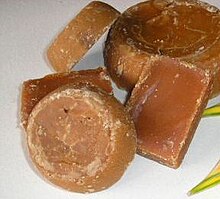SUBTOPIC=Overview
– Panela is unrefined whole cane sugar common in Latin America.
– It is derived from the boiling and evaporation of sugarcane juice.
– Panela comes in various forms like liquid, granulated, and solid blocks.
– Colombian sugarcane production contributes significantly to the country’s economy.
– Colombians are the largest consumers of sugarcane globally.
SUBTOPIC=Uses
– Panela was created for easier sugar transportation.
– It is used in beverages and desserts.
– Panela is broken into smaller pieces for use.
– In Mexico, it is known as piloncillo and used in various desserts.
– In the Philippines, it is used in traditional dishes like latik and kalamay.
SUBTOPIC=Nutritional Value
– Panela per 100g contains 1,600 kJ of energy.
– It has 86.4g of sugars, 0.1g of fat, and 0.2g of protein.
– Panela also contains water, calcium, magnesium, and iron.
– It is a low-cost sweetener with mineral contributions.
– Panela consumption represents a significant portion of food expenditures in some areas.
SUBTOPIC=Health Claims
– Manufacturers claim panela is healthier than refined sugar.
– Advocates suggest it has immunological benefits and a lower glycemic index.
– Panela contains trace amounts of vitamins and minerals.
– Research supporting other health claims is limited.
– The substance is still considered a form of sugar.
SUBTOPIC=Global Impact
– Panela is a key product in Colombia’s rural economy.
– It is the second-largest employer after coffee production in rural areas.
– Colombians consume over 34.2kg of sugarcane per capita.
– Panela represents a significant portion of food expenditures in low-income sectors.
– Worldwide, it is recognized as a low-cost sweetener with mineral benefits.
Panela (Spanish pronunciation: [paˈnela]) or rapadura (Portuguese pronunciation: [ʁapaˈduɾɐ]) is an unrefined whole cane sugar, typical of Latin America. It is a solid form of sucrose derived from the boiling and evaporation of sugarcane juice. Panela is known by other names in Latin America, such as chancaca in Chile, Bolivia, and Peru, piloncillo in Mexico (where panela refers to a type of cheese, queso panela). Just like brown sugar, two varieties of piloncillo are available; one is lighter (blanco) and one darker (oscuro). Unrefined, it is commonly used in Mexico, where it has been around for at least 500 years. Made from crushed sugar cane, the juice is collected, boiled, and poured into molds, where it hardens into blocks. It is similar to jaggery, which is used in South Asia. Both are considered non-centrifugal cane sugars.
 | |
| Alternative names | Piloncillo, chancaca |
|---|---|
| Region or state | |
| Main ingredients | Whole cane sugar |
| Similar dishes | Jaggery, palm sugar |
| Nutritional value per 100 g (3.5 oz) | |
|---|---|
| Energy | 1,600 kJ (380 kcal) |
| Sugars | 86.4 g |
0.1 g | |
0.2 g | |
| Other constituents | Quantity |
| Water | 12.3 g |
| Calcium | 79 mg |
| Magnesium | 81 mg |
| Iron | 12 mg |
Source: http://ccbolgroup.com/chancaca.html | |
Panela is sold in many forms, including liquid, granulated, and solid blocks, and is used in the canning of foods, as well as in confectionery, soft drinks, baking, and vinegar, beer, and winemaking.
